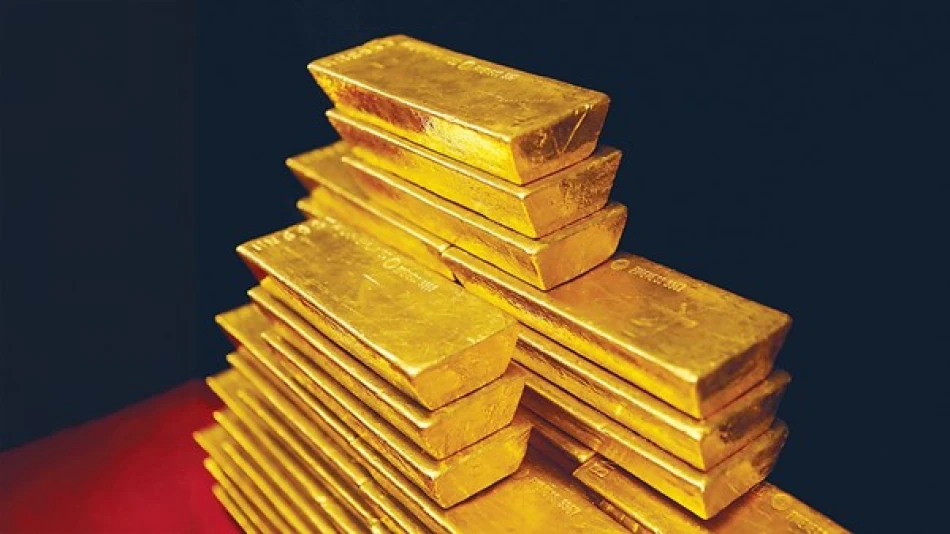
UAE's Surging Demand for Gold Bars and Coins: A 25% Boost
UAE Gold Investment Surge Signals Flight to Safety Amid Global Uncertainty
The United Arab Emirates has emerged as a key driver of global gold investment demand, with bullion and coin purchases jumping 25% year-over-year in Q2 2025 to reach 4.1 tons, according to the World Gold Council. This surge reflects a broader global shift toward safe-haven assets as investors navigate trade policy uncertainty, geopolitical tensions, and record-high gold prices that have fundamentally altered precious metals markets.
UAE Leads Regional Investment Pivot
The Emirates' gold investment appetite has proven remarkably robust, with quarter-on-quarter growth of 31% from Q1 to Q2 2025. This acceleration positions the UAE alongside traditional gold strongholds like India and China as a major consumption center, though with a distinctly different profile focused on investment rather than jewelry.
The trend mirrors broader regional dynamics where Gulf states have increasingly diversified their wealth preservation strategies. Unlike neighboring Saudi Arabia, which has focused heavily on sovereign wealth fund expansion, the UAE's retail and institutional investors appear to be directly accumulating physical gold as portfolio insurance.
Jewelry Market Tells Different Story
While investment demand soared, UAE jewelry consumption declined 16% year-over-year to 7.7 tons in Q2, down from 9.2 tons in the same period last year. This bifurcation between investment and consumer demand reflects gold's evolution from luxury good to financial asset, particularly as prices reached record levels of $3,280.35 per ounce in June.
The jewelry decline suggests price sensitivity among traditional consumers, even in a wealthy market like the UAE. This pattern has emerged across most global markets, where record prices have priced out discretionary buyers while attracting serious investors.
Global Context: Central Banks Slow Their Buying
The UAE's investment surge comes as global gold dynamics shift significantly. Central banks added 166.5 tons to official reserves in Q2, down roughly one-third from Q1 and marking the lowest first-half purchases since 2022. This deceleration suggests that even institutional buyers are becoming more price-conscious after years of aggressive accumulation.
However, the slack from central banks has been more than offset by private investment flows. Global gold ETFs continued strong inflows throughout Q2, while bullion and coin demand posted its strongest first-half performance since 2013.
Investment Thesis Strengthens
Total global gold demand rose 3% year-over-year to 1,249 tons in Q2, but the 45% increase in value terms to $132 billion tells the real story. Investment demand surged 78%, driven by safe-haven positioning and momentum from record prices. This suggests that gold has successfully transitioned from inflation hedge to broader portfolio diversifier.
The investment case has been bolstered by persistent trade policy uncertainty, ongoing geopolitical tensions, and concerns about currency debasement. Unlike previous gold rallies driven primarily by inflation fears, the current cycle reflects broader systemic risk concerns.
Market Implications and Outlook
For precious metals markets, the UAE's investment surge signals important structural changes. The country's position as a global trading hub means its gold demand often reflects broader international capital flows, suggesting institutional and high-net-worth investors globally are increasing precious metals allocations.
Mine production hit a record 909 tons in Q2, yet recycling remained surprisingly weak despite record prices. This supply-demand imbalance supports continued price strength, particularly if investment demand maintains current levels.
Strategic Positioning
The World Gold Council expects investment demand to remain elevated through 2025, though potentially at a slower pace in the second half. Central bank purchases, while slower, remain structurally strong as institutions continue diversifying away from traditional reserve currencies.
For the UAE specifically, the gold investment boom reinforces its position as a regional financial center and safe-haven destination. As global uncertainty persists, the Emirates' combination of political stability, financial infrastructure, and tax advantages makes it an attractive base for precious metals investment strategies.
The current environment suggests gold's role as a portfolio diversifier has been permanently enhanced, with the UAE serving as both beneficiary and catalyst of this transformation in global investment patterns.
Most Viewed News

 Layla Al Mansoori
Layla Al Mansoori






